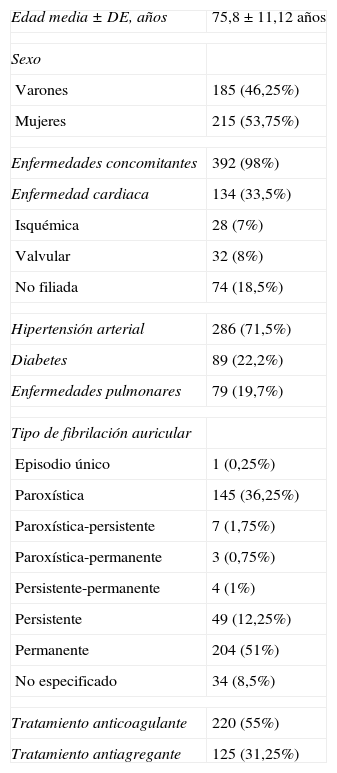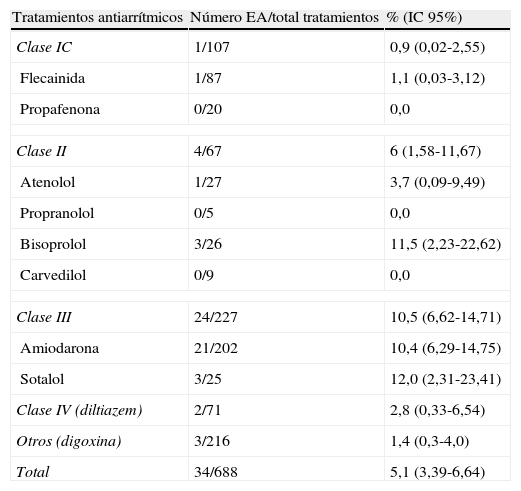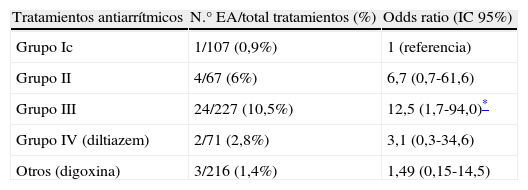Conocer los efectos adversos (EA) de los fármacos antiarrítmicos utilizados para la fibrilación auricular (FA) en condiciones de práctica clínica habitual.
Pacientes y métodoEstudio observacional retrospectivo de base poblacional de todos los pacientes con diagnóstico de FA tratados en un centro de Atención Primaria urbano. Análisis descriptivo del tipo de EA, y de su manejo (técnicas diagnósticas utilizadas, pruebas de laboratorio, tratamiento farmacológico, número de visitas a servicios sanitarios, visitas a urgencias, hospitalizaciones e intervenciones quirúrgicas).
ResultadosSe incluyó a 400 pacientes. En total, se iniciaron 688 tratamientos antiarrítmicos, de los cuales se registraron 32 EA en 30 pacientes, con la implicación de 34 tratamientos (4,9%). Los EA más frecuentes fueron hipotiroidismo (28,1%), hipertiroidismo (25%) y bradicardia (9,38%). En números absolutos, los fármacos de la clase III fueron los que más EA ocasionaron (p=0,001). La tasa de EA registrados por 100 pacientes-año fue: clase I 0,42 (intervalo de confianza del 95% [IC 95%] 0,01-1,15), clase II 2,55 (IC 95% 0,68-5,13), clase III 4,70 (IC 95% 2,98-6,64), clase IV 1,18 (0,14-2,80), otros (digoxina) 0,41 (IC 95% 0,08-1,19). Individualmente, los fármacos con una tasa más elevada de EA fueron sotalol, bisoprolol y amiodarona (5,70, 5,37 y 4,59 respectivamente). Los EA ocasionaron visitas a servicios sanitarios (93,75% de los EA), pruebas de laboratorio (59,38%) y técnicas diagnósticas (56,25%). El 71,9% de los EA se resolvieron sin ninguna secuela y en un caso el desenlace fue el fallecimiento.
ConclusionesLos fármacos antiarrítmicos utilizados en el tratamiento de la FA, especialmente los fármacos de clase III, llevan asociada la presencia de EA, y en conjunto implican un importante consumo de recursos sanitarios.
To determine the adverse effects (AE) of antiarrhythmic drugs used to treat atrial fibrillation (AF) in routine clinical practice.
Patients and methodsA retrospective, observational, population-based study of all patients diagnosed of AF requiring long-term treatment with antiarrhythmic drugs. We performed also a descriptive analysis of the type of EA, and their management (diagnostic techniques, laboratory tests, drug treatment, number of visits to health services, emergency visits, hospitalizations and surgeries).
ResultsWe included 400 patients. Overall, 688 treatments were started, 34 of which (4.9%) were implied in 32 EA in 30 patients. The most frequent EA were hypothyroidism (28.1%), hyperthyroidism (25%) and bradycardia (9.38%). In absolute numbers, class III drugs (Vaughan-Williams classification) were associated with a higher number of AE (p=0.001). The number of AE/100 patients-year was: class I 0.42 (0.01-1.15%), class II 2.55 (0.68-5.13%), class III 4.70 (2.98-6.64%), class IV 1.18 (0.14-2.80%), digoxin 0.41 (0.08-1.19). Individually, the drugs with a higher rate were sotalol, bisoprolol and amiodarone (5.70, 5.37 and 4.59 respectively). 93.75% of EA required visits to health services, 59.38% laboratory tests and 56.25% diagnostic techniques. The most frequent visits were scheduled for primary care (75%), followed by scheduled visits to outpatient cardiology (21.9%). 71.9% of EA were resolved without any sequel and one patient died.
ConclusionsAntiarrhythmic drugs for the management of AF are associated with the presence of AE, mainly class III drugs. In most cases they are not serious, but imply important health resources.
Artículo
Comprando el artículo el PDF del mismo podrá ser descargado
Precio 19,34 €
Comprar ahora












